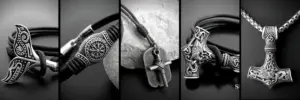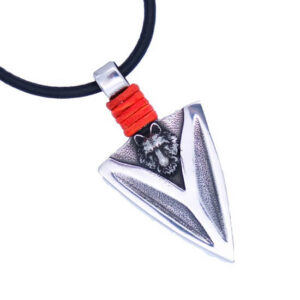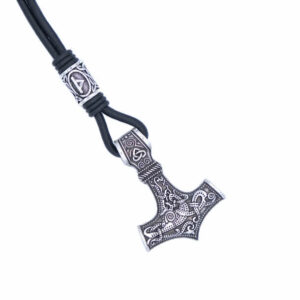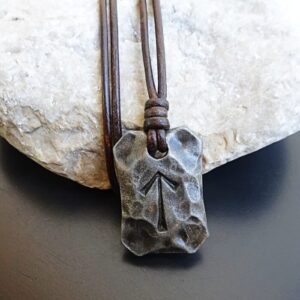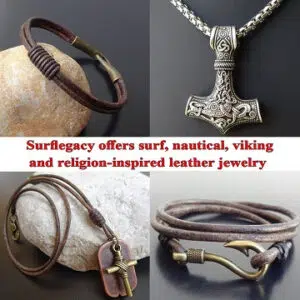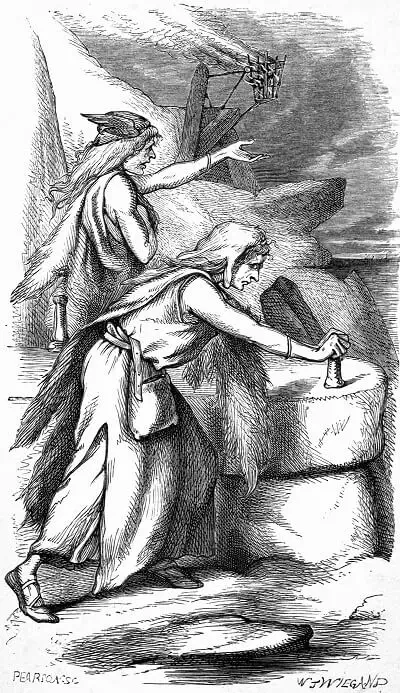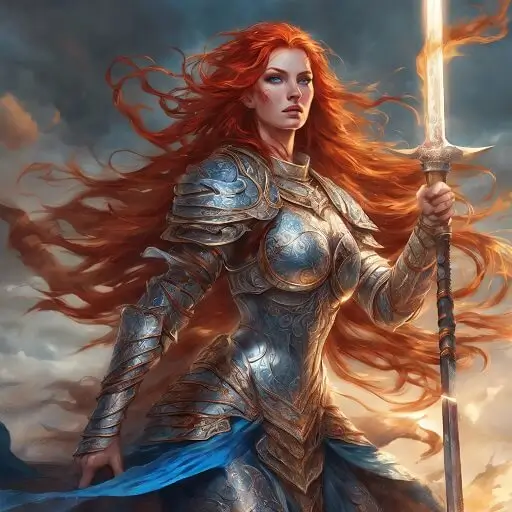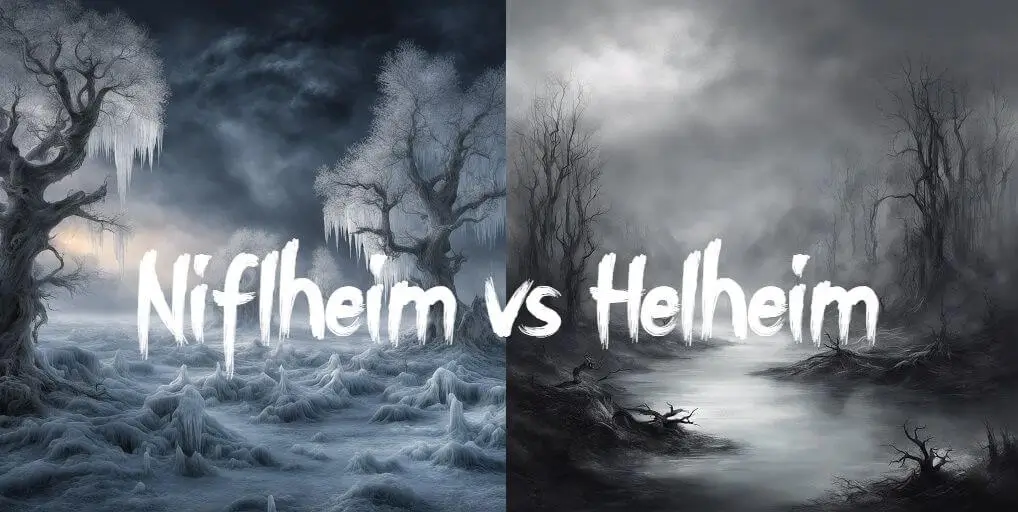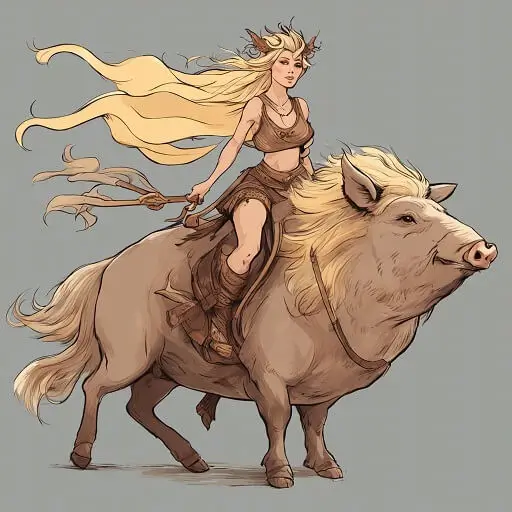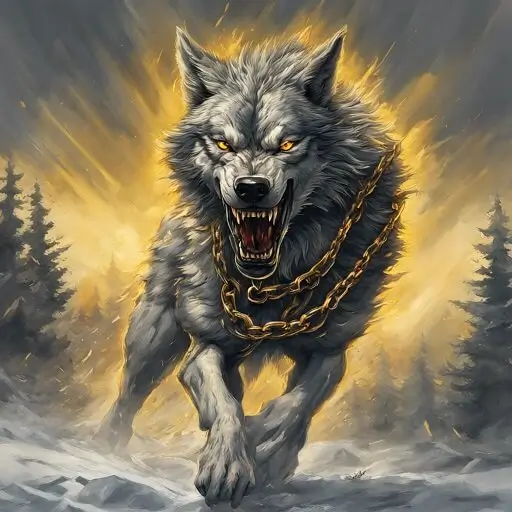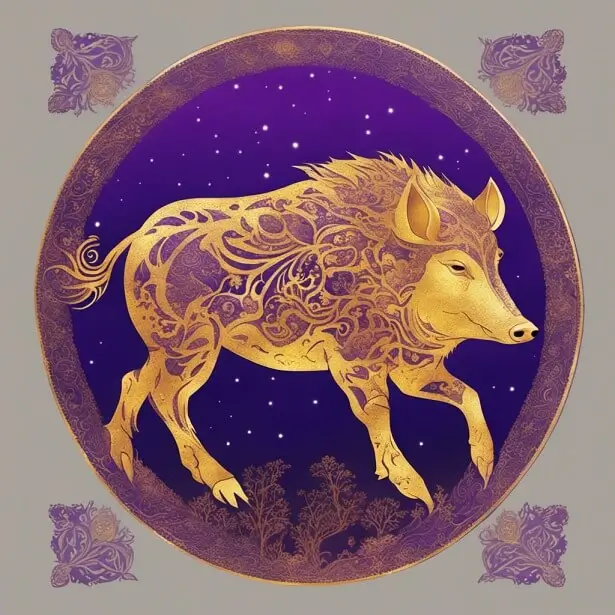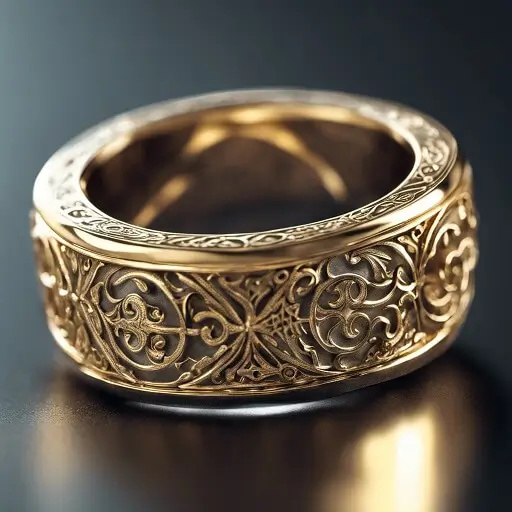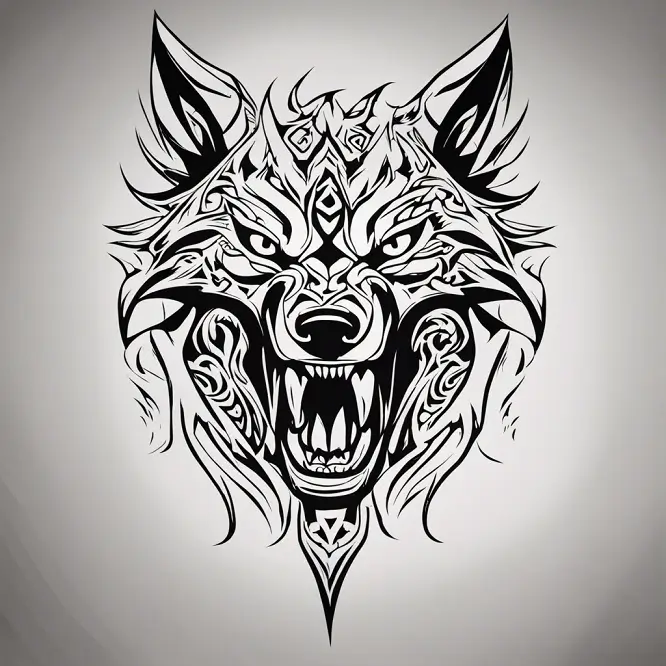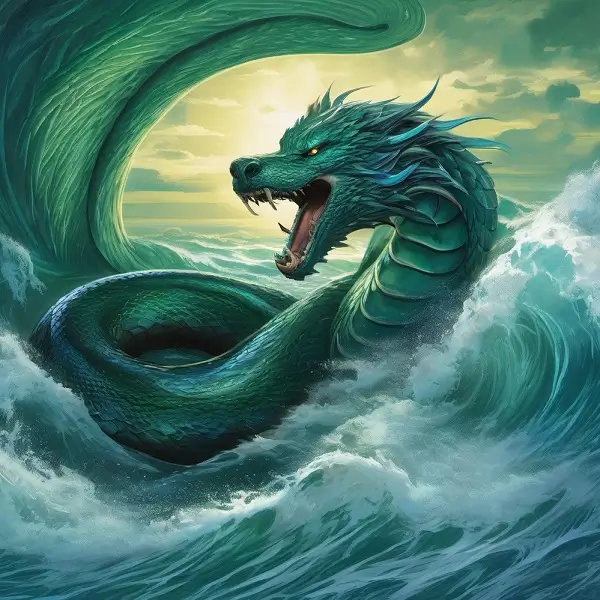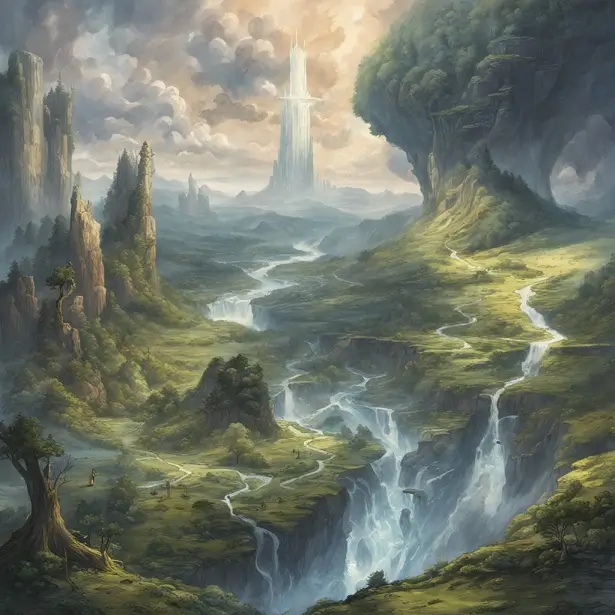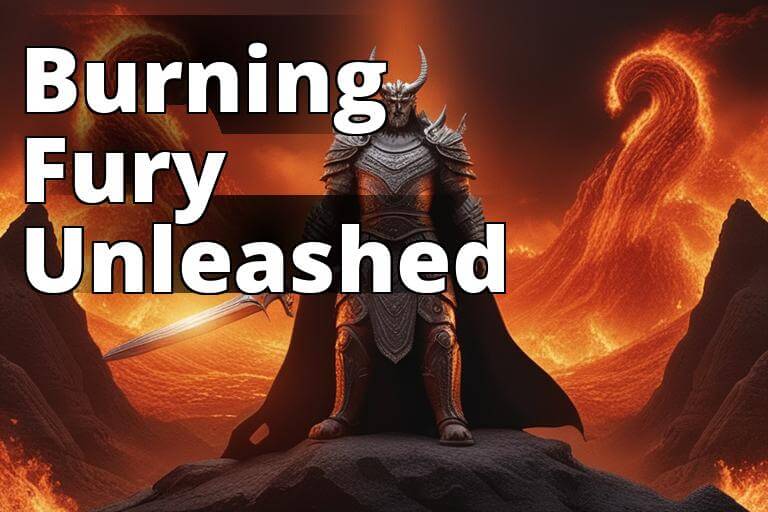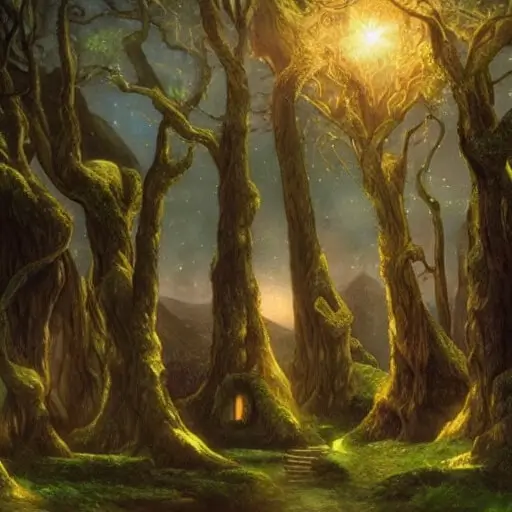Fenrir symbol, an emblem of the monstrous wolf from Norse mythology, has captured the imagination of people for centuries. This powerful and evocative symbol embodies themes of chaos, strength, rebellion, fate, and transformation, making it a fascinating subject for both scholars and enthusiasts alike.
As we delve into the world of the Fenrir symbol, we will explore its origins, meaning, and significance, as well as its continued impact on modern culture and the enduring appeal of Norse mythology.
So, whether you’re a devoted enthusiast of Norse mythology or simply intrigued by the mythical wolf, join us as we unravel the mysteries surrounding the legendary Fenrir symbol.
Key Takeaways:
- The Fenrir symbol depicts the monstrous wolf Fenrir from Norse mythology, typically shown with its mouth open and fangs bared.
- Fenrir was the offspring of Loki and destined to kill Odin, representing chaotic, destructive forces that threaten cosmic order.
- The meaning of the Fenrir symbol relates to chaos, rebellion, fate, transformation, and the struggle between order and chaos.
- Important Norse runes tied to Fenrir include eihwaz (Yggdrasil), tiwaz (Tyr), and thurisaz (giants).
- Fenrir has been artistically depicted from ancient Norse artifacts to modern comics and tattoos.
- Modern pagans connect spiritually with Fenrir’s raw primal power and status as an outsider.
- Fenrir’s myth explores the interplay of creation/destruction and other universal themes that remain relevant.
- The enduring appeal of the complex Fenrir symbol reflects the continued fascination with Norse mythology.
Fenrir’s Origins and Role in Norse Mythology
Fenrir’s story begins with his birth to the infamous trickster god Loki and the giantess Angrboða. This unlikely pairing resulted in the creation of three fearsome offspring: Fenrir the wolf, Hel the goddess of death and the underworld, and Jörmungandr the colossal sea serpent. Each of these siblings would come to play a significant role in Norse mythology, with Fenrir being the most dreaded of them all.
Fenrir’s siblings are equally fascinating figures in Norse mythology. Hel was appointed by Odin to rule over the realm of the dead, known as Helheim, where she would preside over the souls of those who did not die in battle. Jörmungandr, on the other hand, was destined to grow so large that he encircled the entire world, holding his tail in his mouth and creating a boundary between the world of humans and the giants.
As Fenrir grew, so did the gods’ fear of the mighty wolf. His immense size and strength were unrivaled, and a prophecy foretold that Fenrir would play a crucial role in the demise of the gods during the cataclysmic event known as Ragnarok.
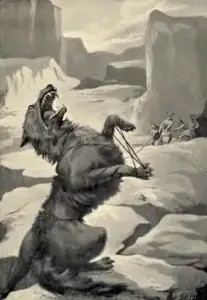
In an attempt to prevent this fate, the gods devised a plan to bind Fenrir with a magical chain called Gleipnir, which was forged by the dwarves and appeared deceptively light and supple. When Fenrir agreed to be bound by the chain, he demanded that one of the gods place their hand in his mouth as a sign of trust. The brave god Tyr volunteered, and when the chain proved unbreakable, Fenrir bit off Tyr’s hand in anger.
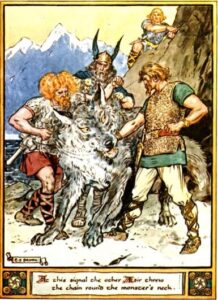
Fenrir biting Tyr’s hand
With Fenrir imprisoned, the gods believed they had forestalled their doom. However, the prophecy of Ragnarok could not be fully averted, and Fenrir would eventually break free from his chains to wreak havoc upon the world and fulfill his role in the annihilation of the gods.
Fenrir’s imprisonment, though seemingly successful at first, would not last forever. As foretold in the prophecy, when Ragnarok began, Fenrir would break free from Gleipnir, his immense strength and ferocity unleashed upon the world.
The great wolf would then engage in a fierce battle against Odin, the Allfather, ultimately devouring him and causing the very destruction that the gods had so desperately tried to prevent.
In the end, Fenrir would meet his own demise at the hands of Odin’s son, Víðarr, who would avenge his father’s death and bring an end to the terror of the monstrous wolf.
Complex Relationships with Fellow Norse Gods
Fenrir’s relationships with gods like Odin and Tyr add further richness and nuance to his symbolism in Norse mythology. His rivalry with Odin seems fated, as the king of the gods seeks to control the wolf’s chaotic power, while Fenrir efforts to Break free of his bonds. Their enmity comes to a head during Ragnarök as Fenrir consumes Odin, despite all his adversaries’ attempts to prevent this destiny.
In contrast, the god Tyr formed an unlikely friendship with Fenrir from the beast’s infancy. By bravely sacrificing his hand to secure the magical binding, Tyr highlights the need for selflessness and willingness to make hard choices for the greater good, even in the face of great personal cost. Their bond gave Fenrir a taste of companionship, while also underscoring his essential isolation as an outsider god.
These complex godly relationships paint Fenrir not merely as an embodiment of destruction, but also as a flawed being yearning for trust, kinship, and understanding. The gods, for all their efforts, cannot escape fate, reminding that even the greatest powers cannot overcome destiny.
Fenrir fundamentally disrupts the established cosmic order, setting in motion the cycle of death and rebirth that Ragnarök represents.
The Fenrir Symbol
The Fenrir symbol, often referred to as the “Fenrisúlfr” in Old Norse, is an artistic representation of the legendary wolf, capturing its fierce and powerful essence. The most common depiction of the Fenrir symbol features the wolf’s head in profile, with its snarling mouth open to reveal sharp fangs and its eyes narrowed, giving it an intense and menacing appearance. The design is often intricate, with knots and patterns inspired by traditional Norse artwork.
Variations of the Fenrir symbol can be found across different cultures and eras, reflecting the influence of Norse mythology on a broader scale. Some versions of the symbol depict Fenrir in the midst of breaking free from his chains, symbolizing the unstoppable force of chaos and destruction.
Others may incorporate additional elements, such as the sun or moon, to represent Fenrir’s role in devouring the celestial bodies during Ragnarok. These variations serve as a testament to the enduring appeal and adaptability of the Fenrir symbol, as well as the widespread fascination with Norse mythology.
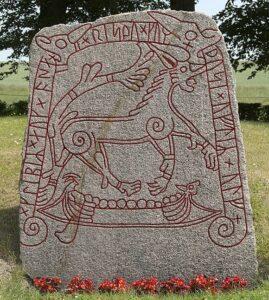
Tullstorp rune stone Fenrir
The connection between the Fenrir symbol and Viking art and artifacts is well-established. Throughout history, the symbol has been found on various items, such as jewelry, weapons, and rune stones, showcasing the prominence of Fenrir in Viking culture.
The Fenrir Symbol: Meaning
So what does the mythic Fenrir represent? First and foremost, he symbolizes an uncontrollable primal power of chaos, violence, and utter destruction. He is a being capable of dismantling the established order and bringing even the mighty gods to doom. In this way, Fenrir represents the vital cosmic counterbalance to order and control in the Norse mythological universe.
The Fenrir symbol holds a deep and layered meaning, drawing from various aspects of Norse mythology and the character of the legendary wolf.
Here are some of the primary meanings and symbolism associated with the Fenrir symbol:
- Chaos and Destruction: As the embodiment of chaos and destruction, Fenrir represents the darker side of existence and the inevitability of turmoil. The symbol serves as a reminder that even the mightiest beings, such as the gods themselves, cannot escape the forces of chaos and the cycle of destruction and rebirth.
- Strength and Power: Fenrir’s immense strength and ferocity are evident in the Fenrir symbol, which often depicts the wolf snarling or breaking free from its chains. The symbol can be interpreted as a representation of strength and the power to overcome obstacles or adversity, even when the odds seem insurmountable.
- Rebellion and Resistance: The tale of Fenrir’s imprisonment and eventual breaking of his chains can be seen as a symbol of rebellion and resistance against oppressive forces. The Fenrir symbol may thus resonate with those who identify with the struggle against tyranny or injustice, embodying the spirit of defiance and the desire for freedom.
- Fate and Prophecy: The story of Fenrir is deeply intertwined with the concept of fate and the prophecy of Ragnarok. The Fenrir symbol, therefore, serves as a reminder of the inescapable nature of destiny and the importance of understanding and accepting one’s path in life.
- Transformation and Rebirth: Despite its association with destruction, the Fenrir symbol also carries with it the notion of transformation and rebirth. As part of the cycle of Ragnarok, Fenrir’s role in the annihilation of the gods ultimately leads to the emergence of a new world. This duality highlights the interconnectedness of destruction and creation, emphasizing that endings are often the catalysts for new beginnings.
The Fenrir symbol is a rich and complex emblem with a multitude of meanings and symbolism drawn from the legendary wolf’s role in Norse mythology. Its representation of chaos, strength, rebellion, fate, and transformation makes the Fenrir symbol a powerful and evocative image that continues to captivate and inspire people across cultures and generations.
What runes are associated with Fenrir?
There are no specific runes that are directly associated with Fenrir in the traditional Elder Futhark runic alphabet. However, some runes may be considered relevant or connected to Fenrir based on their meanings and symbolism. The eihwaz rune represents the world tree Yggdrasil, which Fenrir destroys during Ragnarök in order to usher in the new world that eventually emerges. Here the great wolf performs an act of destruction that enables cosmic renewal.
The rune Thurisaz (ᚦ), which represents the giants or thurses, could be linked to Fenrir due to his giantess mother, Angrboða. Thurisaz also represents chaos, destruction, and uncontrollable forces, which align with the destructive nature of Fenrir.
Another rune that could be connected to Fenrir is Tiwaz (ᛏ), named after the god Tyr. Tyr is closely associated with Fenrir in Norse mythology, as he was the god who sacrificed his hand to bind the wolf with the magical chain Gleipnir. The Tiwaz rune symbolizes courage, bravery, and self-sacrifice, which can be seen in Tyr’s actions in the Fenrir myth.
Other Norse symbols linked to Fenrir include broken chains, representing his inevitable breaking free from bondage, and images of wolves biting or attacking, evoking Fenrir’s fated attack on Odin during Ragnarök. These mythic symbols directly reference pivotal moments in the Fenrir story.
It’s important to note that these connections between runes and Fenrir are interpretative and not explicitly mentioned in the original Norse texts.
Enduring Spiritual Significance of Fenrir in Norse Paganism
For contemporary adherents of Norse paganism, including Ásatrú practitioners, Fenrir holds profound spiritual meaning that extends far beyond merely embodying chaos and destruction. Viewed through a modern pagan lens, Fenrir represents a return to authentic primal forces and the natural cycles of life, death, and rebirth.
Some pagans focus on Fenrir as an avatar of cosmic balance, destroying the old world in order to enable the next cycle of creation. His myth highlights the interdependence of chaos and order. Pagans may perform spiritual rituals asking Fenrir for protection, courage, and guidance when navigating difficult transitions.
Other pagans identify with Fenrir’s isolation and desire for connection. His story becomes a reminder to create inclusive communities that value outcasts and curb prejudice stemming from superficial perceptions. By engaging deeply with Fenrir’s myth, modern pagans unearth timeless spiritual lessons about compassion, open-mindedness, and humanity’s relationship with the natural world.
Fenrir Symbol in Modern Culture
- Fenrir in Pop Culture: The Fenrir symbol and the legendary wolf itself have found their way into various aspects of modern popular culture. Fenrir has appeared in movies, TV shows, books, and games, often serving as a powerful antagonist or a symbol of chaos and destruction. Examples include the portrayal of Fenrir in the Marvel Cinematic Universe, the popular video game series God of War, and the widely-read book series Magnus Chase and the Gods of Asgard by Rick Riordan. The continued presence of Fenrir in popular media showcases the enduring appeal of Norse mythology and its iconic characters.
- Norse Mythology in Contemporary Art and Design: The growing popularity of Norse mythology has had a significant impact on contemporary art and design. Artists, designers, and creative professionals draw inspiration from the myths and legends, incorporating Norse symbolism, imagery, and themes into their work. The Fenrir symbol, as an integral part of Norse mythology, has seen a resurgence in various forms of art, such as illustrations, sculptures, and graphic design projects. The influence of Norse mythology in contemporary art and design not only preserves these ancient tales but also introduces them to new generations, ensuring their continued relevance and popularity.
- Fenrir Symbol in Tattoo Art: The Fenrir symbol has become a popular choice for tattoos, with individuals drawn to the symbol for various reasons. Some may choose the Fenrir symbol to represent their admiration for Norse mythology, while others may be drawn to the symbol’s associations with strength, rebellion, or transformation. The intricacy of the Fenrir symbol, with its elaborate patterns and designs, lends itself well to tattoo art, allowing for unique and striking interpretations of the legendary wolf. For many, a Fenrir tattoo serves as a powerful and personal reminder of the values and themes embodied by the mythological creature.
The Lasting Impact of the Fenrir Symbol
- Continued Relevance and Significance: The Fenrir symbol remains relevant and significant in modern times due to its deep connections to the themes and values that continue to resonate with people today. The symbol’s associations with chaos, strength, rebellion, fate, and transformation reflect the ongoing human fascination with these powerful concepts, as well as our innate desire to understand and overcome the challenges that life presents. By evoking such profound ideas, the Fenrir symbol maintains its significance and impact in contemporary culture.
- Universal Themes and Messages: The Fenrir myth, like many other stories in Norse mythology, contains universal themes and messages that can be drawn upon and applied to various aspects of life. The tale of Fenrir teaches us about the inescapable nature of fate, the duality of destruction and rebirth, and the importance of facing adversity with courage and determination. These timeless themes serve as a reminder of our shared humanity and the experiences that bind us together, transcending cultural and historical boundaries.
- The Enduring Power and Appeal of Norse Mythology: The lasting impact of the Fenrir symbol is, in part, a testament to the enduring power and appeal of Norse mythology as a whole. These ancient tales, filled with larger-than-life characters and dramatic narratives, continue to captivate audiences around the world, inspiring countless adaptations, interpretations, and creative works. The Fenrir symbol, as an iconic representation of one of Norse mythology’s most intriguing and formidable creatures, stands as a symbol of the mythology’s enduring appeal, ensuring that these ancient stories will continue to enchant and inspire future generations.
Fenrir symbol FAQ
How do modern pagans honor Fenrir in their practices?
Pagans may honor Fenrir in rituals requesting protection, courage, and guidance during transitions. Some meditate on his myth to reflect on community, empathy, and overcoming bias. Fenrir is incorporated into storytelling, ceremonial altar spaces, and rune magic. Rituals may coincide with seasons/events representing cosmic change.
Why does Fenrir’s myth remain impactful today?
Fenrir’s myth continues to resonate because it explores timeless themes of our inner primal drives, the balance between order and chaos, the inevitability of change, and the desire for trust and belonging. As civilization tames wild forces, Fenrir reminds us of our connection to powerful natural cycles. His story provides perspective as we navigate life’s mysteries.
Is the Fenrir symbol commonly used as a protective symbol or talisman?
While the Fenrir symbol may not be explicitly used as a protective symbol, its associations with strength and power can make it appealing as a personal talisman or emblem for those who feel connected to these qualities.
How is the Fenrir symbol related to other symbols in Norse mythology?
The Fenrir symbol is one of many symbols derived from Norse mythology. Others include the Valknut, which is associated with Odin, and the Vegvísir, a Viking compass symbol. These symbols each represent different aspects of Norse mythology and can be connected through shared themes, such as fate, transformation, and power.
Can the Fenrir symbol be found in Viking burial sites or other archaeological contexts?
While the Fenrir symbol is not as commonly found in archaeological contexts as other symbols, such as the Valknut or the Mjölnir (Thor’s hammer), you can find depictions of Fenrir or wolf-like imagery in Viking art, such as the one in Tullstorp Runestone
What is the historical significance of the Fenrir symbol in Viking society?
The Fenrir symbol, like many other symbols in Norse mythology, reflects the cultural and spiritual beliefs of Viking society. Its presence in art and artifacts demonstrates the importance of the Fenrir myth and the values it embodies, such as strength, courage, and the inescapable nature of fate.
How has the Fenrir symbol influenced modern fantasy literature and world-building?
The Fenrir symbol and the myth surrounding the monstrous wolf have inspired many authors and creators in developing their fantasy worlds, incorporating elements of Norse mythology, including the concept of a powerful, menacing, and destructive creature.
Are there any connections between the Fenrir symbol and werewolf Mythology?
While not directly connected, the Fenrir symbol and werewolf mythology both feature powerful, fearsome wolves. The concept of a monstrous wolf may have influenced later werewolf legends in European folklore, with both Fenrir and werewolves embodying themes of transformation and primal power.
How has the Fenrir symbol been adapted in contemporary fashion and jewelry design?
The Fenrir symbol has been embraced by modern fashion and jewelry designers, who incorporate the emblem into their creations, often reimagining it in a contemporary style while maintaining its traditional elements. Such designs can be found on clothing, accessories, and jewelry, appealing to fans of Norse mythology or those attracted to the symbol’s powerful imagery.
What role does the Fenrir symbol play in the modern resurgence of interest in pagan and Norse spiritual practices?
As interest in pagan and Norse spiritual practices grows, the Fenrir symbol has become a point of connection for those drawn to these traditions. The symbol can be used in rituals, ceremonies, or as a personal emblem to represent the qualities and themes associated with Fenrir, such as resilience, rebellion, and transformation.
Can the Fenrir symbol be seen as a metaphor for overcoming personal challenges and embracing one’s inner strength?
The Fenrir symbol, with its associations with strength, power, and breaking free from constraints, can be viewed as a metaphor for overcoming personal challenges and embracing one’s inner strength. By identifying with the symbol, individuals may find inspiration and motivation to confront their fears, break free from limitations, and transform their lives.
Final Thoughts
Far more than a mere destructive beast, Fenrir encapsulates a rich mixture of archetypal themes and natural forces within his Norse mythological narrative. His legend will continue to evolve and inspire new perspectives across ages and cultures.
By tracing his mythological trajectory from ancient Norse texts through modern popular culture, we can fully appreciate how Fenrir has become such an enduring symbol of cosmic destruction and renewal, as well as an avatar of our own untamed inner nature.
The primal power of the Fenrir myth calls to us even today, reminding that creation and destruction are intertwined halves of the same whole. With his complex story and symbolism, Fenrir represents a vital touchpoint linking past and present understandings of our human relationship with the mysterious cosmic forces that shape reality.
Shop Norse Jewelry
Are passionate about Vikings or Norse Myths?
Finding the ideal piece of Viking Jewelry can be challenging and time-consuming, especially if you lack inspiration or don’t know where to look.
Surflegacy, has you covered. We have a wide range of Handmade Jewelry in various styles, shapes, colors, and materials, to accentuate your Viking spirit and look. Do not hesitate to visit our selection HERE
Whatever you wear, you’ll find the ideal trendy piece to complement your wardrobe. Our jewelry is designed to be worn every day, no matter where you go or what season is. Are you ready to step up your wardrobe game?



